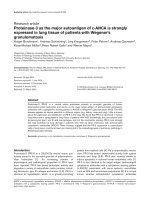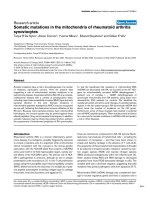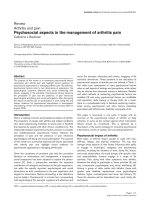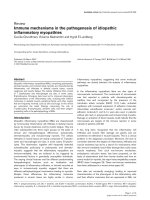Báo cáo y học: " Ethnic differences in the adaptation rate of HIV gp120 from a vaccine trial" ppsx
Bạn đang xem bản rút gọn của tài liệu. Xem và tải ngay bản đầy đủ của tài liệu tại đây (189.06 KB, 3 trang )
BioMed Central
Page 1 of 3
(page number not for citation purposes)
Retrovirology
Open Access
Short report
Ethnic differences in the adaptation rate of HIV gp120 from a
vaccine trial
Marcos Pérez-Losada*
1
, David Posada
2
, Miguel Arenas
2
, David V Jobes
3
,
Faruk Sinangil
4
, Phillip W Berman
5
and Keith A Crandall
6
Address:
1
CIBIO, Centro de Investigação em Biodiversidade e Recursos Genéticos, Universidade do Porto, Campus Agrário de Vairão, 4485-661
Vairão, Portugal,
2
Departamento de Bioquímica, Genética e Inmunología. Universidad de Vigo, 36310 Vigo, Spain,
3
Presidio Pharmaceuticals,
Inc., San Francisco, CA 94158, USA,
4
Global Solutions for Infectious Diseases, South San Francisco, CA 94080, USA,
5
Department of Biomolecular
Engineering, University of California, Santa Cruz, CA 95064, USA and
6
Department of Biology, Brigham Young University, Provo, UT 84602, USA
Email: Marcos Pérez-Losada* - ; David Posada - ; Miguel Arenas - ;
David V Jobes - ; Faruk Sinangil - ; Phillip W Berman - ;
Keith A Crandall -
* Corresponding author
Abstract
Differences in HIV-1 gp120 sequence variation were examined in North American volunteers who
became infected during a phase III vaccine trial using the rgp120 vaccine. Molecular adaptation of
the virus in vaccine and placebo recipients from different ethnic subgroups was compared by
estimating the d
N
/d
S
ratios in viruses sampled from each individual using three different methods.
ANOVA analyses detected significant differences in d
N
/d
S
ratios among races (P < 0.02). gp120
sequences from the black individuals showed higher mean d
N
/d
S
ratios for all estimators (1.24–1.45)
than in other races (0.66–1.35), and several pairwise comparisons involving blacks remained
significant (P < 0.05) after correction for multiple tests. In addition, black-placebo individuals
showed significantly (P < 0.02) higher mean d
N
/d
S
ratios (1.3–1.66) than placebo individuals from
the other races (0.65–1.56). These results suggest intrinsic differences among races in immune
response and highlight the need for including multiple ethnicities in the design of future HIV-1
vaccine studies and trials.
Findings
More than 33 million people are currently infected with
HIV-1, resulting in 2–3 million deaths every year. Natural
immunity to the virus is virtually nonexistent; hence, the
creation of a vaccine to combat this global pandemic is an
international public-health priority [1,2]. In 2003, the
results were released for a phase III HIV-1 vaccine efficacy
trial conducted in North America and The Netherlands
(VAX004) [3]. This study tested the efficacy of bivalent
vaccines containing recombinant HIV-1 envelope glyco-
protein 120 (rgp120) antigens, the major antigen on the
surface of the virus [4]. Overall, the vaccine candidate did
not seem to reduce the incidence of HIV-1 infection, but
an interesting trend was noted in the analysis of the differ-
ent self-described ethnic groups [white (non-Hispanic),
blacks, Hispanic, Asian, and "others"]. When only the
non-white volunteers (17% of the total study population)
were considered, the vaccine seemed to confer a slight
benefit (P = 0.012). After adjustment for multiple tests,
this difference was not significant (P = 0.13) [3]. Despite
a lack of statistical support, this is not a trivial result. If this
trend was to be confirmed, it would imply that non-
Published: 15 July 2009
Retrovirology 2009, 6:67 doi:10.1186/1742-4690-6-67
Received: 3 May 2009
Accepted: 15 July 2009
This article is available from: />© 2009 Pérez-Losada et al; licensee BioMed Central Ltd.
This is an Open Access article distributed under the terms of the Creative Commons Attribution License ( />),
which permits unrestricted use, distribution, and reproduction in any medium, provided the original work is properly cited.
Retrovirology 2009, 6:67 />Page 2 of 3
(page number not for citation purposes)
whites developed protective immunity to HIV-1 or, even
more important, that rgp120 immunogens could protect
against HIV infection under certain circumstances. Here
we explored this possibility further.
HIV-1 evolution is driven, to a significant extent, by the
immune response. If viruses isolated from non-white
patients are in fact under a stronger selection pressure
either because of genetic differences in the magnitude,
specificity, or potency of the natural immune response, or
because of differences in factors affecting virus replication,
we should expect higher ratios of nonsynonymous
(amino acid changing) to synonymous nucleotide substi-
tutions (d
N
/d
S
) [5-8] than in viral samples isolated from
vaccinated and placebo (non-vaccinated) white individu-
als.
To test whether levels of selection were significantly differ-
ent between vaccinated and placebo individuals in differ-
ent races, we analyzed 3 clones per individual from 345
infected North Americans from the VAX004 study (Table
1; data available at
). Full-length HIV-
1 subtype B gp120 sequences were amplified as described
in Gilbert et al. [9]. Since, as expected, viruses isolated
from individuals from the same race did not form mono-
phyletic groups [10], viral samples for each patient were
analyzed separately. In each case, individual clones were
aligned in MAFFT v5.7 [11], and d
N
/d
S
ratios were esti-
mated using Nei and Gojobori's method [6] in SNAP [12],
model M0 (one-ratio) in PAML v3.14 [13], and Fixed
Effects Likelihood (FEL) with tree branch correction in
HYPHY [14]. In the latter case, we took recombination
into account by first detecting recombination breakpoints
with GARD [15], and then estimating the d
N
/d
S
ratios
independently for each fragment.
Mean d
N
/d
S
ratios across races and treatments were com-
pared using ANOVA, linear models (lm) and pairwise t-
tests. Because treating all non-whites as a single unit is
unrealistic considering their own genetic differences [3],
we tested for differences in selection pressure on a race-by-
race basis. Multiple significance in the pairwise t-tests was
corrected using the Benjamini and Hochberg's procedure
[16].
The estimates of d
N
/d
S
obtained with SNAP, PAML and
HYPHY were all significantly correlated among the differ-
ent estimators used (correlation coefficient > 0.85; P <
0.001). Importantly, the mean d
N
/d
S
ratios varied across
races (Table 1), and these differences were globally signif-
icant (ANOVA;P < 0.02) for SNAP and PAML estimates.
Blacks (vaccinees and placebo combined) showed higher
d
N
/d
S
ratios for all the estimators than individuals from
other ethnicities (Table 1). Significant differences (pair-
wise t-tests; P < 0.05) between black and white, Hispanic
and "others" viral samples were observed for all the esti-
mators before corrections, but only the comparisons
involving SNAP and PAML estimates remained significant
after the Benjamini and Hochberg's adjustment (Table 2).
The higher d
N
/d
S
ratios observed for blacks suggest that the
rate of virus evolution is greater in this group than in other
volunteers. Differences in immune response to HIV-1
infection have been pointed out by the rgp120 HIV Vac-
cine Study Group [3] as one of the potential factors to
explain vaccine efficiency differences between white and
non-white volunteers in the VAX004 trial. Ethnic differ-
ences in immune response have been also reported for
other viruses such as the hepatitis C virus [17].
Does the greater virus adaptive variation presumed in
black participants reflect genetic differences in the intrin-
sic (no-preconditioned) immune response to HIV-1, or is
it a consequence of the conditioned immune response
induced by vaccination with rgp120? Comparison of vac-
cine and placebo recipients showed different results based
on the d
N
/d
S
estimators used. No significant differences
were observed among vaccinees, but significant differ-
ences (ANOVA; P = 0.025) in SNAP d
N
/d
S
ratios were
detected among placebo individuals. Moreover, black-
placebo patients showed significantly (lm coefficients; P <
0.02) higher mean d
N
/d
S
ratios (1.3, 1.38 and 1.66, for
SNAP, PAML and HYPHY, respectively) than the other
races (0.65–1.01, 0.84–1.14 and 0.73–1.56, respectively).
These results might indicate that natural differences in the
immune response may have increased viral rgp120 adap-
tation in blacks.
In North America, blacks correspond to 42% of all newly
diagnosed HIV/AIDS cases, while white (non-Hispanic)
and Hispanic individuals represent approximately 40%
and 17%, respectively [18]. If more data including both
Table 1: Mean d
N
/d
S
estimates across patients in PAML, SNAP and HYPHY.
White (291) Hispanic (22) Black (12) Asian (5) Other (15)
SNAP 0.709 0.750 1.240 0.818 0.659
PAML 0.839 0.826 1.411 1.346 0.751
HYPHY 0.949 0.729 1.453 0.720 1.202
Individuals analyzed are indicated between parentheses.
Retrovirology 2009, 6:67 />Page 3 of 3
(page number not for citation purposes)
placebo and vaccinated recipients confirm that selection
pressure differs between viruses infecting these three races,
deciphering the genetic determinants of these differences
should become a public-health priority. Indeed, our
results highlight the need for selecting a broader represen-
tation of volunteers, based on ethnicity, in the design of
future HIV-1 vaccine studies and trials [19].
Competing interests
The authors declare that they have no competing interests.
Authors' contributions
MPL, DP, and KC developed the genetic and statistical
strategies implemented in this work. MPL, DP, and MA
performed the genetic and statistical analyses. DVJ, FS,
and PWB carried out the molecular genetic studies and
immunoassays. All authors participated in the design of
the study and helped to draft the manuscript. All authors
read and approved the final manuscript.
Acknowledgements
This study was supported by a Bill & Melinda Gates Foundation grant to
Global Solutions for Infectious Diseases. It was also supported by the Span-
ish Ministry of Science and Education [grant number BIO2007-61411 to DP,
FPI fellowship BES-2005-9151 to MA]. We also want to thank the reviewers
for their excellent suggestions.
References
1. Esparza J, Bhamarapravati N: Accelerating the development and
future availability of HIV-1 vaccines: why, when, where, and
how? Lancet 2000, 355:2061-2066.
2. Spearman P: HIV vaccine development: lessons from the past
and promise for the future. Curr HIV Res 2003, 1:101-120.
3. rgp120 HIV Vaccine Study Group: Placebo controlled phase 3
trial of a recombinant glycoprotein 120 vaccine to prevent
HIV-1 infection. rgp120 HIV Vaccine Study Group. J Infect Dis
2005, 191:654-665.
4. Eggink D, Melchers M, Sanders RW: Antibodies to HIV-1: aiming
at the right target. Trends Microbiol 2007, 15:291-294.
5. Sharp PM: In search of molecular Darwinism. Nature 1997,
385:111-112.
6. Nei M, Gojobori T: Simple methods for estimating the num-
bers of synonymous and nonsynonymous nucleotide substi-
tutions. Mol Biol Evol 1986, 3:418-426.
7. Ross HA, Rodrigo AG: Immune-mediated positive selection
drives human immunodeficiency virus type 1 molecular var-
iation and predicts disease duration. J Virol 2002,
76:11715-11720.
8. Williamson S: Adaptation in the env gene of HIV-1 and evolu-
tionary theories of disease progression. Mol Biol Evol 2003,
20:1318-1325.
9. Gilbert PB, Peterson ML, Follmann D, Hudgens MG, Francis DP, Gur-
with M, Heyward WL, Jobes DV, Popovic V, Self SG, et al.: Correla-
tion between immunologic responses to a recombinant
glycoprotein 120 vaccine and incidence of HIV-1 infection in
a phase 3 HIV-1 preventive vaccine trial. J Infect Dis 2005,
191:666-677.
10. Pérez-Losada M, Jobes DV, Sinangil F, Crandall KA, Posada D, Berman
PW: Phylodynamics of gp120 sequences from a Phase 3 HIV-
1 vaccine trial in North America. Mol Biol Evol 2009. in review
11. Katoh K, Kuma K, Toh H, Miyata T:
MAFFT version 5: improve-
ment in accuracy of multiple sequence alignment. Nucleic
Acids Res 2005, 33:511-518.
12. Korber B: HIV signature and sequence variation analysis. In
Computational and evolutionary analysis of HIV molecular sequences Vol-
ume 4. Edited by: Rodrigo AG, Learn GH. Dordrecht, Netherlands:
Kluwer Academic Publishers; 2000:55-72.
13. Yang Z: PAML: Phylogenetic Analysis by Maximum Likeli-
hood. 3.1th edition. London: University College London; 2001.
14. Kosakovsky Pond SL, Frost SDW, Muse SV: HyPhy: hypothesis
testing using phylogenies. Bioinformatics 2005, 21:676-679.
15. Kosakovsky Pond SL, Posada D, Gravenor MB, Woelk CH, Frost SD:
GARD: a genetic algorithm for recombination detection.
Bioinformatics 2006, 22:3096-3098.
16. Benjamini Y, Hochberg Y: Controlling the false discovery rate: a
practical and powerful approach to multiple testing. J R Statist
Soc B 1995, 57:289-300.
17. Sugimoto K, Stadanlick J, Ikeda F, Brensinger C, Furth EE, Alter HJ,
Chang KM: Influence of ethnicity in the outcome of hepatitis
C virus infection and cellular immune response. Hepatology
2003, 37:590-599.
18. CDC: HIV/AIDS Surveillance Report. Volume 19. Atlanta: Cent-
ers for Disease Control and Prevention (CDC); 2007.
19. Graham BS, Mascola JR: Lessons from failure – preparing for
future HIV-1 vaccine efficacy trials. J Infect Dis 2005,
191:647-649.
Table 2: Statistically significant comparisons of d
N
/d
S
estimates among races and race-treatments.
Race Race by treatment
Method ANOVA Corrected pairwise t-tests ANOVA lm coefficient
SNAP (0.011) black vs hispanic (0.020)
black vs other (0.013)
black vs white (0.004)
(0.025) black placebo (0.001)
PAML (0.019) black vs hispanic (0.047)
black vs other (0.047)
black vs white (0.033)
black placebo (0.016)
HYPHY black placebo (0.015)
Values in parentheses are P-values.









